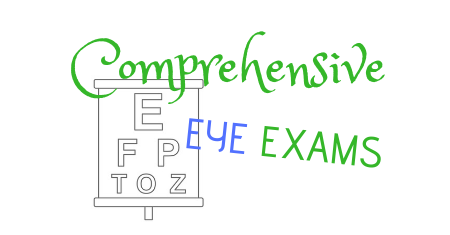Why and When You Need Comprehensive Eye Examinations
September 23, 2018

Everyone needs a thorough, or comprehensive, eye exam. Regardless of age or vision, comprehensive eye exams can uncover more than just blurry vision. Adults, older adults and children should all get routine eye exams.
In this article, we review why you need them, when to get them and what’s involved.
Comprehensive eye exams can be a part of a proactive healthcare plan. In addition to diagnosing potential sight threatening eye diseases, many systemic diseases can be uncovered as well. Diabetes, high blood pressure, autoimmune disease, hypercholesterolemia and thyroid disorders are such examples.
When to Get Exams
The American Academy of Ophthalmology (AAO) recommends a baseline eye exam at around age 40 for adults. This is generally about the time when presbyopia develops.
Routine examination should follow and look for evidence of glaucoma, cataracts or macular degeneration. The prevalence of eye disease increases as we age. Remember that many eye diseases do NOT affect vision until late in the course of the disease. Prevention of eye disease with early detection and treatment is key.
The American Optometric Association (AOA) recommends that children first get eye examinations at 6 months, 3 years of age and at the start of school. Follow the advice of your eye doctor or pediatrician.
Children should then get an exam every two years if no problems are detected during the early exams. As children grow, their need for glasses can change every year.
Why Get Exams
For adults, the chances of developing eye diseases such as glaucoma, cataracts or macular degeneration increases from year to year. The chance of developing diabetes increases, too. Diabetic retinopathy is a leading cause of blindness. Early detection of glaucoma, cataracts, macular degeneration or diabetic retinopathy can reduce the chances of severe vision loss during your lifetime.
Children, too, should have thorough eye exams looking for motility disorders, lazy eye (amblyopia) or the need for glasses. Congenital eye disease can be detected at an early age.
The Comprehensive Exam
A comprehensive eye exam includes a complete medical and family history. Many systemic diseases have eye manifestations and eye disease may “run” in families.
Vision is usually assessed with use of a Snellen eye chart. Vision with and without glasses (if needed) is recorded for each eye and at varying distances (reading and far, for example). Your peripheral vision will be checked. An automated visual field may be used if screening tests indicate a problem.
Pupils are tested for their response to a bright light. It’s normal for both pupils to react symmetrically.
Eye pressure can be taken a variety of ways. Eye pressure is a risk factor for glaucoma.
A slit lamp allows your eye doctor to exam your eyes under magnification and with special light beams. The eyelids, conjunctiva, cornea, iris, sclera and lens are examined with the slit lamp.
Pupils should be dilated allowing further examination of your lens, optic nerve, vitreous, macula and retina. Specialized lenses are often used in addition to the slit lamp.
Eye diseases increase with age. Regular comprehensive examination can often prevent vision loss. Children can also have eye problems. Check with your eye doctor, primary care provider or pediatrician for their recommendations.
If you would like to make an appointment with Drs. Whitten or Rose, you may CALL US or USE OUR CONTACT FORM.



